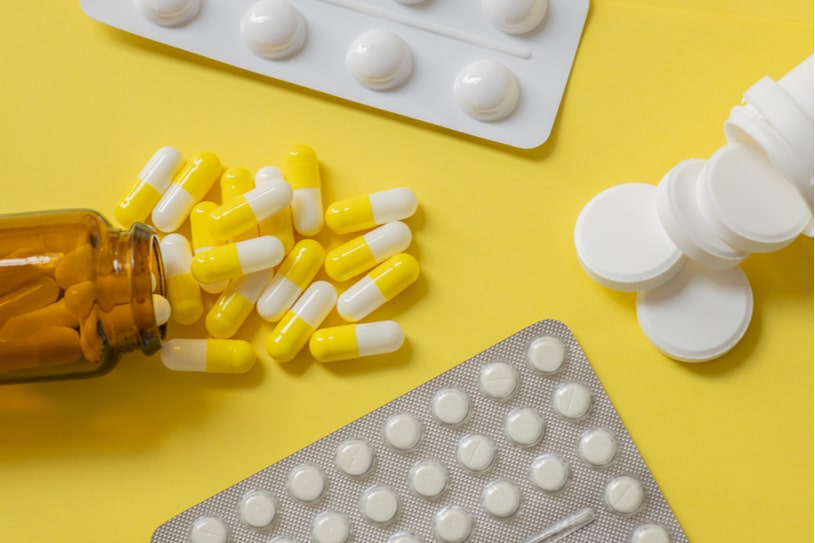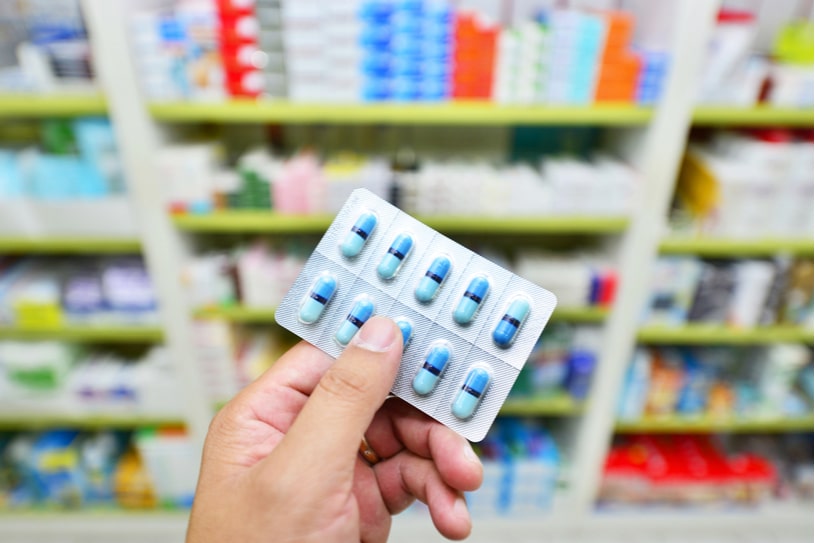There are different prescription medications, for example, muscle relaxers and sleeping pills. Although these drugs are prescribed by a medical doctor, when abused, it causes harm to health. In the research report series of the National Institute on Drug Abuse, it was stated that around 53 million individuals in the United States used these drugs for nonmedical reasons at least once in their lifetimes, and 20% of those are 12 years old and above.
Table Of Contents:
Additionally, in 2010, it was reported that the opioid Oxycontin was the most abused prescription substance. For patients taking these medications, it is essential to understand the dangers of the abuse of prescription drugs.
In this article, information about the types of prescription drugs, controlled substance drugs, signs, symptoms, and dangers of medication abuse, the half-life of prescription drugs, and how to treat medication addiction will be provided.
What Is a Prescription Drug?
A prescription drug, also known as an Rx drug, is a medication that can only be legally dispensed when there is a medical prescription provided. But, it does not mean that when a drug is a prescription substance, there are no other over-the-counter counterparts. For example, aside from prescription muscle relaxers, there are also OTC muscle relaxers. Furthermore, also known as ethical drugs, these substances are considered Rx-only because of the following reasons:
- There are some health risks associated with their use such as addiction
- The medication administration should be given by a healthcare professional
- There is a potential for misuse that can lead to prescription drug overdose
Generally, these medications are safe to use. However, when they are abused and misused, such as when taken in higher doses or when mixed with other substances like alcohol, health dangers could occur.
Prescription Drug Types
There are many prescription drug types in the market, especially nowadays when the healthcare system continually blooms. Since there are different health issues affecting everyone, different drugs are being made available to treat those conditions. Among these, the most common ones are opioids, CNS depressants, and stimulants. Another reason why these substances are considered prescription is because of their addictive properties.
Central Nervous System Depressants
Drugs in this category work like alcohol – they slow down brain functions. Sometimes referred to as sedatives, most of these drugs work by adjusting the levels of the neurotransmitter GABA (gamma-aminobutyric acid) in the brain. This chemical is implicated in the communication system between cells. When its levels are changed or reduced, communication slows down, which is why depressants can be prescribed for anxiety disorders or posttraumatic stress disorder.
The CNS depressants include benzodiazepines, non-benzodiazepines, and barbiturates. According to a study by Psychiatrists from the University of Michigan, it was reported that around 5.3 million people in the United States misused benzodiazepines, and 5.2% of these people are of ages 18-25 years old.
The abuse of prescription drugs, could cause the following side effects, and the severity is increased when taken with alcohol:
- Confusion
- Headache and dizziness
- Uncontrollable eye movements
- Memory problems
- Slurred speech
The barbiturates include mephobarbital, phenobarbital, and pentobarbital sodium. Additionally, the non-benzodiazepines include zolpidem, eszopiclone, and zaleplon. Lastly, the benzodiazepines include diazepam, clonazepam, alprazolam, triazolam, estazolam, midazolam, and temazepam.
Stimulants
As the name suggests, stimulants tend to enhance or boost brain function. They are commonly prescribed for attention deficit disorder and similar conditions where the focus is impeded. People suffering from these conditions tend to feel worried and nervous all the time, but their focus and attention return when they take stimulants.
Based on the report of the National Institute on Drug Abuse, around 5 million individuals in the United States abuse and misuse stimulant drugs. Eventually, this could cause some of the following side effects:
- Bloodshot eyes
- Chills or sweating
- Increased blood pressure, body temperature, and heart rate
- Dilated pupils
- Hyperactivity
- Loss of appetite and weight loss
- Nausea or vomiting
- Sleeping less than usual
- Slowed breathing
- Weight loss
Because stimulants come with a high propensity for abuse and addiction, many doctors prefer to avoid prescribing these medications. Some of the stimulants include Adderall, dextroamphetamine, methamphetamine, methylphenidate, modafinil, lisdexamfetamine, and phentermine.
Opioids
Opioids are the most addictive Rx drugs. This medication class includes painkillers and thus has a very wide range of applications. In 2019, it was reported that around 10.5 million individuals in the United States misused opioid drugs. Specifically, 9.7 million of this population misused painkiller opioids.
Eventually, prescription drug abuse could cause the following side effects:
- Constipation
- Memory problems
- Inability to concentrate
- Moving less or more slowly
- Nausea or vomiting
- Scratching at the skin
- Sleepiness and slowed breathing
- Slurred speech
Some examples of opioids include codeine, morphine, Percocet, fentanyl, oxycodone, hydrocodone, hydromorphone, oxymorphone, tramadol, and Vicodin. In the case of prescription pill addiction, there is hope through the help of rehabilitation centers.

Controlled Substance Prescription
When it comes to Rx drugs, there are also controlled substances. This means that the manufacture, possession, and use of these drugs are regulated by the government. Additionally, these controlled substances are placed in different five drug schedules, and the placement depends on the following:
- Whether they have a currently accepted medical use in treatment in the United States
- Abuse and addiction potential
- Dependence potential
Moreover, the most common, controlled, and uncontrolled, drugs that are highly addictive include methadone, meperidine, oxycodone, fentanyl, morphine, opium, amphetamine, amobarbital, glutethimide, buprenorphine, benzphetamine, phendimetrazine, ketamine, and anabolic steroids.
Prescription Drug Abuse And Addiction Overview
Prescription drug addiction is often difficult to establish as the use of this medication is medically legitimate. In the United States, drug misuse is alarming. In the 2020 research report series of the National Institute on Drug Abuse, it was reported that around 9.3 million individuals in the country misused opioid painkillers. Additionally, 6.2 million and 5.1 million individuals misused CNS depressants and stimulants, respectively.
According to statistics of the 2014 National Survey on Drug Use and Health, over 2 million people in the US used Rx drugs for non-medical reasons for the first time that year, which corresponds to approximately 5,750 first-time Rx medication users per day. The majority of them were females, with approximately every third person being an adolescent.
Signs And Symptoms Of Prescription Drug Abuse And Addiction
Using a prescription medication outside the intervention of a medical doctor could lead to medication abuse, dependence, and addiction. Because of this, it is important to know the signs and symptoms of prescription drug abuse and addiction.
The physical signs and symptoms of prescription drug addiction and abuse include the following:
- Constipation
- Nausea
- Slowed breathing
- Drowsiness
- Poor coordination
- High blood pressure
- Irregular heartbeat
Sometimes, increased sensitivity to pain can also be seen in patients abusing opioids. In one study from Spain, it was reported that too much opioid exposure can cause the patients to be more sensitive to painful stimuli. Aside from physical signs and symptoms of medication abuse, there are also psychological ones. Some of these include the following:
- Confusion
- Sleep disruption
- Doctor shopping to gain more prescriptions
- Memory problems
- Anxiety
Most of the time, relationships with friends and families are also affected. So, for patients who want to wean off these substances safely, resources such as rehab centers would be of great help. In these centers, patients will be given a safe detoxification process to avoid withdrawal syndrome.
Who Is Most At Risk Of Prescription Drug Abuse And Addiction?
Those who are using Rx drugs have the potential to abuse these substances. However, there are still some factors that can increase the risk of abuse of prescription drugs. As cited in one research from the University of Rhode Island, in 2017, it was reported that nearly 17 million individuals in the United States were misusing Rx drugs, and adults ages 18 to 25 have the highest rates of drug misuse.
- Prescription Abuse Among Teenagers – In one publication from the Substance Abuse and Health Services Administration, it was reported that the abuse of prescription drugs is greatly affecting the lives of teenagers. In 2014, more than 5,700 youth were reported to be using medications without the guidance of a medical doctor. Consistent with the 2003 National Survey on Drug Use and Health, the rates of prescription drug abuse are highest among 18-25 years old.
- Abuse of Prescription Drugs Among the Elderly – Every fourth patient aged 57 to 85 uses at least one Rx drug daily, and over half of these patients take more than five medications every day. This population is particularly at risk of prescription drug addiction and abuse because of high rates of chronic illnesses, often characterized by constant pain, the potential of drug interactions, and age-related changes in drug metabolism. A large percentage of older adults also take dietary supplements and over-the-counter medication, which may exacerbate any adverse effects on health resulting from the (improper) use of drugs, especially in combination with alcohol.
- Prescription Drug Abuse Among Women – Based on the report from the Los Angeles County Department of Mental Health, more men than women misuse these drugs in all age groups except 12 to 17 years. The recreational use of all three types of Rx drugs is more frequent among teenage girls. In terms of nonmedical users, females in the above age group are also more likely to meet the medical criteria of an Rx medication use disorder. At present, prescription abuse, drug misuse, and overdose incidences are more frequent among men, but the rates of prescription abuse and overdose among women are increasing faster.
- Race and Living Arrangement – In another research by Pharmacists from Maryland, it was stated that white females and those with non-spousal others are more likely to abuse these medications. These groups are also likely to use more than one Rx medication with addiction potential.
Based on one study published in the American Clinical and Climatological Association, prescription pill addiction can start at home. For patients who wish to quit these medications, addiction treatment can be given at rehabilitation centers.
Dangers of Prescription Drug Abuse And Addiction
Taking Rx drugs under the supervision of a medical doctor can provide a wide range of benefits. Generally, these drugs would provide effective treatment or remedy to their targeted health concerns. However, if these substances are abused, aside from medication addiction, they could lead to dangerous events such as overdose, withdrawal, and damage to organs.
- Prescription Drug Overdose – One of the dangers of prescription drug addiction and abuse is overdose. Over the last 15 years, it was reported that there has been an increase in the number of emergency room visits because of Rx drug misuse, and overdose deaths are alarming. Prescription drug overdose death has increased from 3,442 in 1999 to 17,029 in 2017.
- Rx Drug Withdrawal – This withdrawal syndrome is also an issue when it comes to prescription drugs. According to researchers from Italy, these Rx drugs that can cause withdrawal include opioids, antidepressants, antiepileptics, and antipsychotics.
- Damages to organs – Like the OTC medications, abusing Rx drugs could damage the organs in the body, especially the kidneys. Based on the study of medical professionals from Brazil, antidepressants are the most common Rx drugs that can cause kidney injury. Eventually, those with pre-existing kidney diseases who are abusing these prescription drugs can exacerbate their health condition.
In case of overdose, seek emergency help as soon as possible. Call 911 or the poison center for proper treatment. In the case of Rx drug withdrawal, considering drug detox kits from rehab centers would also be of great help. Lastly, patients experiencing prescription pill addiction may be given a safe drug intervention treatment.

How Long Does a Prescription Drug Stay in the System and Drug Testing
There are short-acting and long-acting Rx drugs. This means that these substances can also provide different half-lives. Since some of these medications, especially stimulants, may cause a false positive drug test with prescription, it is necessary to know how long these drugs stay in the system.
For opioids, the short-acting ones such as codeine, hydrocodone, oxymorphone, and morphine, come with a half-life between 2-3 hours. On the other hand, long-acting opioids such as buprenorphine, fentanyl, hydromorphone, methadone, oxycodone, tapentadol, and tramadol, come with a half-life between 12-150 hours.
For CNS depressants, the half-lives also depend on the class of drugs. Short-acting barbiturates come with a half-life of 4-38 hours. On the other hand, long-acting barbiturates offer a half-life of 59-182 hours. For benzodiazepines, the short-acting ones come with a half-life of 1-12 hours, the intermediate benzos come with a half-life of 12-40 hours, and long-acting benzos have a half-life of 40-250 hours.
Lastly, for stimulants, the average half-life of the short-acting ones is 2-3 hours. On the other hand, long-acting stimulants have a half-life of 8-12 hours. In case a patient is taking Rx drugs, specifically opioids, CNS depressants, and stimulant drugs will undergo a drug test, it is highly advised to bring proof of prescription for drug test. If ever there is a false-positive result, a patient can show the proof of prescription for drug test to defend himself/herself.
Getting Help for Prescription Drug Abuse
People who abuse Rx drugs are among those that need professional help most often because they frequently require medical detox services. Drug addiction treatment helps patients kick an Rx medication habit. Abuse of CNS depressants, for instance, can lead to seizures when the person tries to stop on their own, while people abusing opioids may experience severe flu-like symptoms when they attempt to quit. A medical detox program, such as detox drinks or detoxification at home, can apply alternative therapies and medicine as well as other techniques to limit distress, making sure withdrawal is safe and unpleasant sensations are brought down to a minimum.
Drug rehab programs, either inpatient or outpatient, often combine cognitive-behavioral and medication therapy. That means recovering addicts who enroll in these programs can work with medication addiction specialists or therapists to find out why they started abusing drugs in the first place and how to prevent a relapse. Therapy makes it possible to learn coping skills that can be applied to rise to relapse challenges after completion of the program.
Hope Without Commitment
Find the best treatment options. Call our free and confidential helpline
Most private insurances accepted
Page Sources
- Convertino, I., Sansone, A. C., Marino, A., Galiulo, M. T., Mantarro, S., Antonioli, L., ... & Tuccori, M. (2016). Neonatal adaptation issues after maternal exposure to prescription drugs: withdrawal syndromes and residual pharmacological effects. Drug safety, 39(10), 903-924.
- Coupey, S. M. (1997). Barbiturates. Pediatrics in Review, 18(8), 260-265.
- Fine, P. G., Mahajan, G., & McPherson, M. L. (2009). Long-acting opioids and short-acting opioids: appropriate use in chronic pain management. Pain medicine, 10(suppl_2), S79-S88.
- Hughes, A., Williams, M. R., Lipari, R. N., Bose, J., Copello, E. A. P., & Kroutil, L. A. (2016). Prescription drug use and misuse in the United States: Results from the 2015 National Survey on Drug Use and Health. NSDUH Data Review, 9, 1-30.
- Kimko, H. C., Cross, J. T., & Abernethy, D. R. (1999). Pharmacokinetics and clinical effectiveness of methylphenidate. Clinical pharmacokinetics, 37(6), 457-470.
- Marion Lee, M., Sanford Silverman, M., Hans Hansen, M., Vikram Patel, M., & Laxmaiah Manchikanti, M. D. (2011). A comprehensive review of opioid-induced hyperalgesia. Pain physician, 14, 145-161.
- Maust, D. T., Lin, L. A., & Blow, F. C. (2019). Benzodiazepine use and misuse among adults in the United States. Psychiatric services, 70(2), 97-106.
- McLellan, A. T. (2017). Substance misuse and substance use disorders: why do they matter in healthcare?. Transactions of the American Clinical and Climatological Association, 128, 112.
- Prescription medicines overview. (2019, November 18). Therapeutic Goods Administration (TGA). https://www.tga.gov.au/prescription-medicines-overview
- Sampaio, T. L., Martins, A. M. C., de Sousa Alves, R., & Magalhães, E. P. (2021). Prescription drug overdose, depression, and other mental disorders in the context of kidney disease. Nephrology and Public Health Worldwide, 199, 155-161.
- Shaw, K., Mitchell, G., & Hilton, D. (2000). Are stimulants addictive in children? What the evidence says. Australian family physician, 29(12), 1202-1204.
- Simoni-Wastila, L., Zuckerman, I. H., Singhal, P. K., Briesacher, B., & Hsu, V. D. (2006). National Estimates of Exposure to Prescription Drugs with Addiction Potential in Community-Dwelling Elders: REGULAR ARTICLES. Substance Abuse, 26(1), 33-42.
- Skibiski, J., & Abdijadid, S. (2020). Barbiturates. In StatPearls [Internet]. StatPearls Publishing.
- Summary of Misuse of Prescription Drugs. (2022, January 21). National Institute on Drug Abuse.

 Authored by
Authored by  Reviewed by
Reviewed by 

